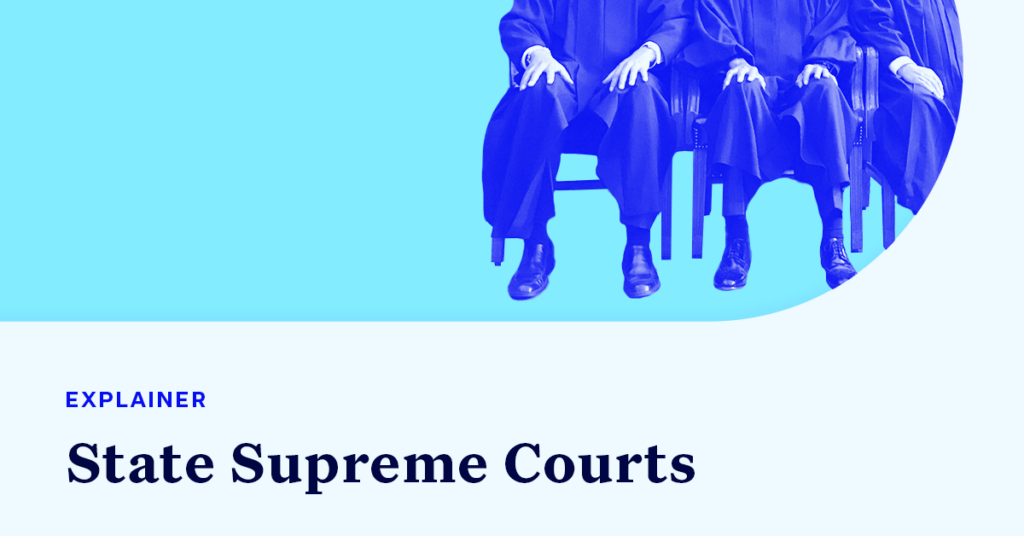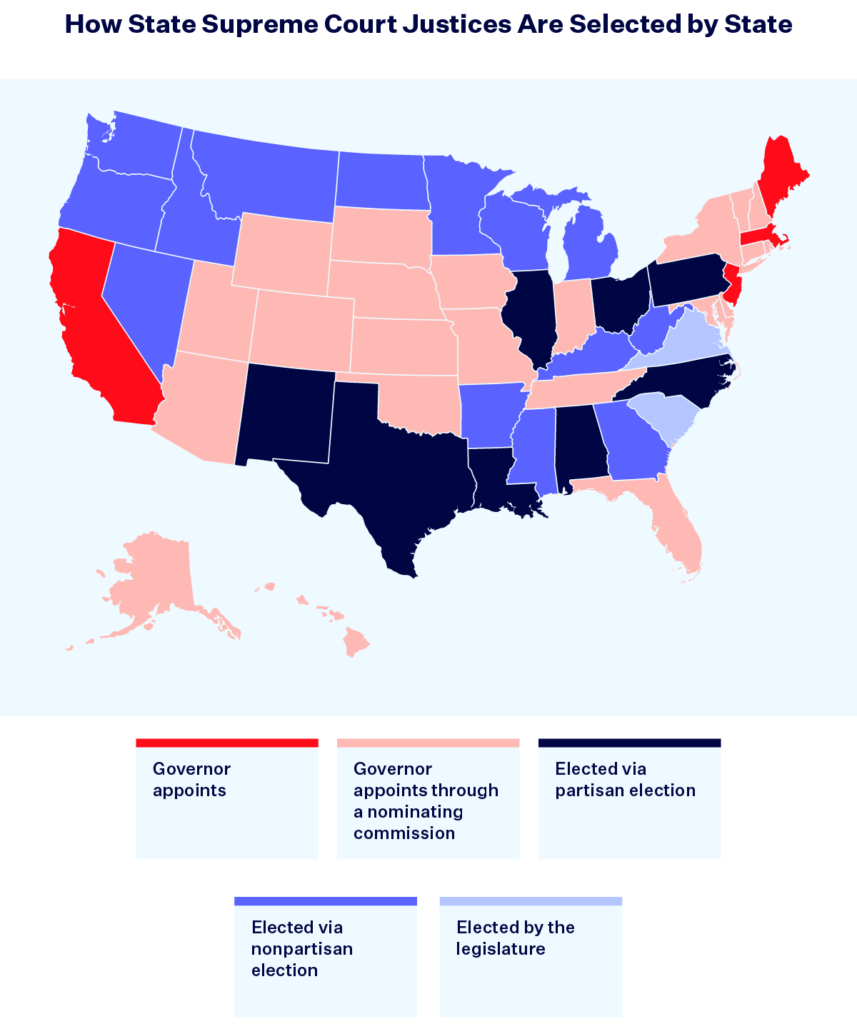How State Supreme Court Justices Are Selected

In the United States, all 50 states as well as Washington, D.C. have at least one court that serves as a state’s highest judicial body. Most often referred to as state Supreme Courts (although some states refer to them by a different name), these courts of last resort issue decisions on matters of state law that are final. In certain scenarios, final decisions from state Supreme Courts can be appealed to the U.S. Supreme Court, which has the authority to review final decisions from state Supreme Courts, but only when they deal with the U.S. Constitution or federal law.
There are a few main paths for justices to end up on a state Supreme Court that involve either being appointed or elected. In this Explainer, we only focus on the processes that are used in the initial selection of a justice to fill a judicial vacancy at the end of another justice’s term. Notably, the processes used for filling an interim judicial vacancy in the middle of a justice’s term and for re-selecting an incumbent justice to serve another term often differ from the initial selection method that was used. For example, a justice might be initially nominated by the governor and then re-selected to serve another term via a retention election.
Below, we outline the various ways in which state Supreme Court justices end up on the bench throughout the United States as of 2023. Note that the process for judicial selection to a state Supreme Court within a given state can be changed through legislation.

In 26 states, state Supreme Court justices are appointed.
In 26 states plus Washington, D.C., state Supreme Court justices are selected through an appointment process. In some states, the governor directly appoints justices. More commonly, the governor appoints justices through a nominating commission, an independent entity that assists with the judicial appointment process by compiling and sending a list of recommended candidates to the governor. The governor then appoints a judicial nominee from this list in order to fill a judicial vacancy. In some states, these lists of recommended candidates are non-binding, while in other states they are binding, meaning the governor must select from the list of potential nominees presented by the nominating commission.
In 24 states, state Supreme Court justices are elected.
In 24 states, state Supreme Court justices are elected either via a nonpartisan, partisan or legislative election. Of the 24 states that elect their state Supreme Court justices, 14 states hold nonpartisan elections, meaning that the judicial candidates run without a party affiliation.
Conversely, eight states hold partisan state Supreme Court judicial elections in which the candidates run with a party affiliation. These states include: Alabama, Illinois, Louisiana, New Mexico, North Carolina, Ohio, Pennsylvania and Texas (note that in New Mexico, justices are selected via a hybrid method in which they are initially appointed by the governor but then run in partisan races in the next general election cycle following their appointment).
In recent years, certain states — including North Carolina and Ohio — switched their method for electing state Supreme Court justices from nonpartisan to partisan elections. In North Carolina specifically, the state Supreme Court judicial selection method changed from nonpartisan to partisan elections in 2018 after the Legislature enacted legislation altering the process. Although state Supreme Court judicial elections do not typically receive the same amount of mainstream media attention that is given to other races, they are nevertheless extraordinarily consequential. Importantly, in the 2022 midterm elections, the North Carolina Supreme Court flipped from a Democratic to a Republican majority, a shift that has already critically impacted the trajectory of voting rights and redistricting litigation in the Tar Heel State.
Finally, in just two states — South Carolina and Virginia — state Supreme Court justices are selected by a vote of the state legislature.
Why are state Supreme Courts important and what role do they play in shaping voting rights and democracy?
State Supreme Courts play a crucial role in adjudicating a variety of important democracy-related matters. As the courts of last resort in a given state, state Supreme Courts have the power of final judicial review over consequential voting rights lawsuits. In addition to deciding cases over state laws and state constitutional provisions that regulate voting and elections, state Supreme Courts often have the final authority to review a state’s legislative and congressional maps. In doing so, they can serve as safeguards against unfettered partisan gerrymandering in redistricting in order to ensure the enactment of fair electoral maps. Furthermore, state Supreme Courts have the power of final review over other election-related matters such as recounts and election contests.
The importance of state judicial systems and state Supreme Courts in particular, as the final arbiters in democracy-related litigation, is only becoming more pronounced in today’s landscape. As Democracy Docket found in its 2022 litigation report, state courts had an outsized impact in the arena of democracy-related litigation, largely due to the fact that parties that filed these types of lawsuits primarily brought claims under state laws. In fact, the report noted that 76% of democracy-related lawsuits were filed in state courts, further demonstrating the profound impact of state courts and state constitutions in shaping our democracy. From the Wisconsin Supreme Court’s 2022 decision banning drop boxes to the Pennsylvania Supreme Court’s 2022 decision prohibiting undated mail-in ballots from being counted, it is clear that state Supreme Court jurisprudence directly impacts voters, elections and democracy and will continue to do so in the future.